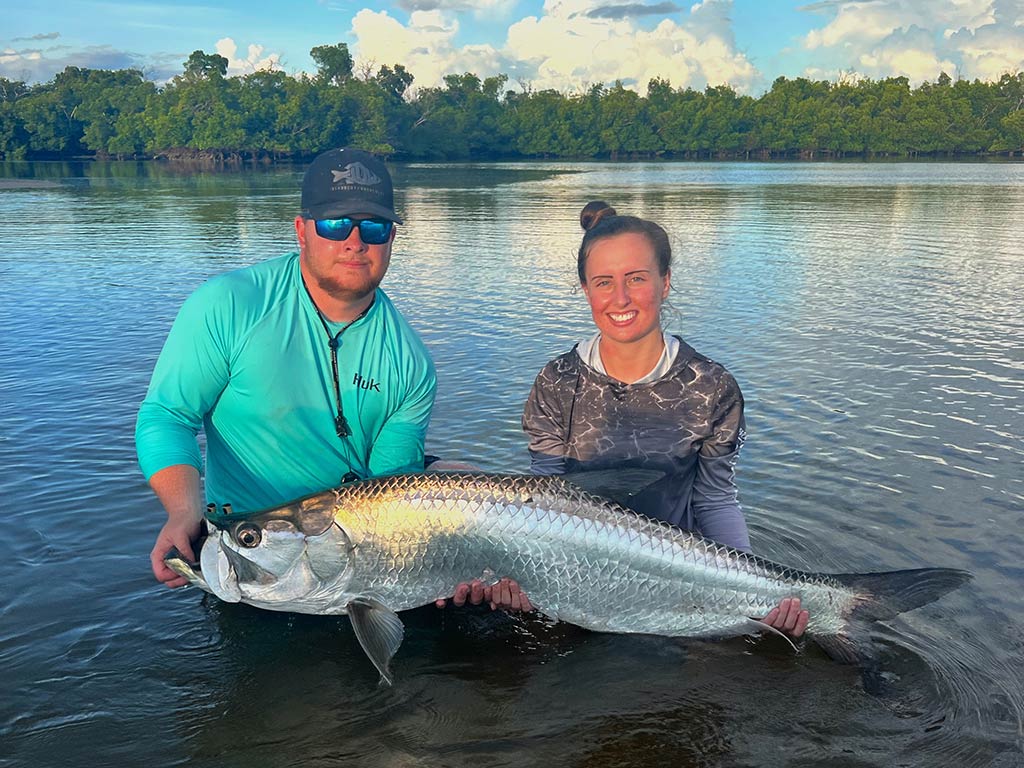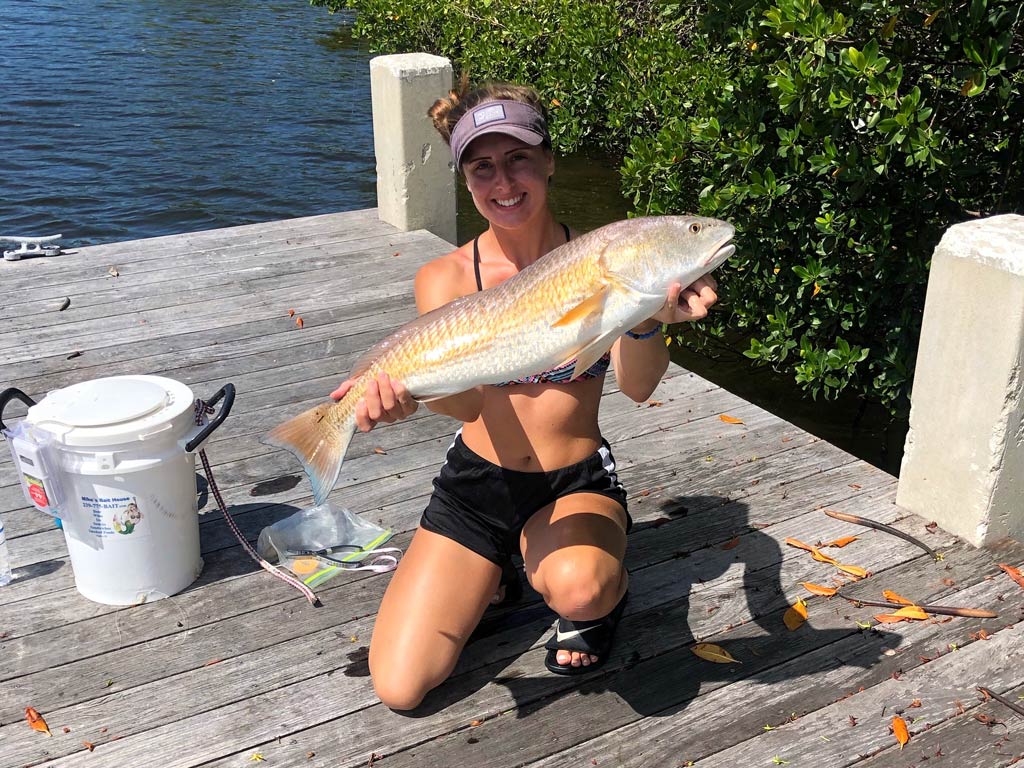Have you ever wondered what a full day looks like for an inshore angler? I’m talking about all the details – the bait, the environments and species you may come across, the techniques, the gear and setups… Depending on your region and targeted species, your day may look a little different than for other anglers.

One thing is for sure, though. Being an inshore angler can be demanding. It’s sometimes tiring but it’s almost always exhilarating and rewarding – especially if you can land your next personal best catch! Follow along as I share some tips, tricks, and my own personal experience as an inshore angler. Let’s get started!
Schedule for the Day & What to Expect
You can come out successful on an inshore angling fish on morning trips, evening trips, and even sun-up to sun-down adventures. This is true whether you plan on fishing from land, kayak, or boat. But before we start, here are a few key tips from me:
- Make sure you find enough shade, bring plenty of water and food, and are prepared to use plenty of strength throughout the day.
- Watch the water for wakes and splashes from nearby fish, and diving birds. This is a sign of bait – and possible predators.
- Pay attention to the clouds and wind, as sometimes this gives you cover and a chance at hooking fish that come out away from the heat.
- Or it can mean a change in conditions, and a storm could be coming in. Always be careful!
Now that I’ve got that out of the way, let’s take a look at what separates mornings from evening inshore trips. As an experienced inshore angler, I’ll break them down so you can see what a day in my inshore life looks like.
Note that I usually fish Naples, Marco Island, the Ten Thousand Islands, and the Everglades. But most of these tips and techniques apply anywhere…
Early Morning Trips
My least favorite! Early morning trips consist of waking up at 3–4 a.m., hitting the quiet Wawa on the way to the ramp, and starting your adventure off in the dark. We set up our anchor lights, turn on the spotlight, and navigate our way through the barely visible mangrove maze.

We sometimes hit the dark and quiet islands first to find some live bait. But we sometimes go straight to our sunrise honey hole with topwaters on our line. A few spots we tend to hit in the mornings consist of flats, oyster beds, points, and mangrove lines.
Angling inshore in the morning provides pretty good results, as a lot of fish are active and feeding during the early dawn hours. We like to use topwater lures and paddle tails to entice hungry fish on the flats or near the shallow groves. If I have live bait, I’ll throw it right up against structure or into a flowing current and let it sit. We also sometimes throw live bait with sinkers down at bridges, piers, and jetties.
In my area, we face terrible mosquitoes and no-see-ums before sunrise. And it can also be a little cold at times. Once the sun comes out to play, though, there are some gorgeous colors over the tropical horizon and the temperature starts to warm up. I love the warmth, but fishing in the summer months can bring some extreme and uncomfortable heat – not to mention storms!

The best morning trips consist of a high, incoming tide where all the structure and mangrove roots are submerged and the water flows inshore. The species we see vary on each trip, but we catch a lot of Snook, Seatrout, Ladyfish, and Snapper. After a few hours, we take a lunch break to fuel up and get a break from the sun, and sometimes even take a swim break too. These trips last a few hours, usually with us heading home in early afternoon.
Evening Trips

I love a good evening trip! When I say evening, I mean we get to the ramp in the early or mid-afternoon and stay out until dark – with sunset being the main attraction. We ride out to the islands first, cast netting finger mullet and any large pilchards we can find. We’ve also used crabs before, taking our bait to spots similar to morning fishing as well as the mangroves of the Ten Thousand Islands.
When there’s a high, outgoing tide, I can cast my bait into the flowing current or along the oyster beds or mangroves, and freeline it and let it sit. We start our evening adventures off by hitting the flats and points, later heading into the backwaters. A lot of our honey holes are best fished in the evening, especially for Tarpon. The fish are more active and incredibly feisty – although they can feed in the mornings, too.
Similar to lunch on the water, we usually have a light dinner on the water. For me, this is typically a chicken, lettuce, and ranch wrap – in between the later afternoon hours of fishing. Once the sun starts to shift and we know our sunshine time is limited, we start preparing. We put on our thicker long sleeves, a buff, a hat, sunglasses, and we spray ourselves with bug repellent. In Florida, evening fishing brings tons of bugs – and I mean tons!

The action can get quite crazy. Picture yourself throwing your topwater or waiting on your live mullet… All of a sudden, your bait gets lunged on. You feel an incredible thump. Next thing you know, your drag starts screaming, the line flies out of your rod tip, and bam! A thick, bony head appears, followed by those large silver scales. A Tarpon lunges out of the water, thrashing all sorts of ways as the water splashes everywhere, right as you see a Snook or Jack blowing up on bait nearby. The big fish quickly falls back in the water, making a huge splash as it hits the surface…
It’s getting dark. Yet the beautiful red, pink, and orange hues of the dimming sun light up the sky and water. Now that’s what you can experience when evening fishing inshore!
Necessary Inshore Gear & Recommended Setups
So, you know what a day in the life of an inshore angler looks like. Let’s now talk about gear that’s good to bring along.
First up, safety gear! You’ll want pliers and hook removers in case you land something with sharp teeth. Don’t forget a first aid kit, sunscreen, UPF clothing (shirts, hats, buffs), non-slip footwear, and polarized sunglasses. It’s wise to have a smartphone or emergency device on you in case you need to call for help, too. If you’re on a boat, bring USGG-approved life jackets, a throwable, a whistle, and flares. Regardless of whether you’re fishing on land or boat, a headlight or flashlight is also very useful if you’re fishing in the dark.
With safety down, let’s dive into inshore angling setup recommendations!
Land-Based Fishing

If you’re casting from a sandy shore, jetty, dock, pier, or mangrove edge, bring a cast net, bait bucket with a bubbler, bait net, some hooks, lures, leaders, and a backpack to carry it all. A medium‑action rod and spinning reel of 2000 or more with 10–15+ lb braid and a 20+ lb fluorocarbon leader is great for working live bait or pitching soft plastics. You can step up your strength and go higher if there are large fish in your area.
Boat Fishing

When you’re away from society and out on the water, you should pack a little heavier to hook up to bigger fish. You’ll want a medium‑heavy rod and a 4000 and up spinning reel for 20+lb braid with a 30–80 lb leader. Bring circle hooks, split shots and sinkers, soft‑plastics, topwater lures, and jerk baits.
One more thing to mention… Whether you’re inshore angling adventure takes place on land or on a boat, you’ll need a valid saltwater fishing license. You can get yours easily online, at Bass Pro or Walmart, some bait shops, and other select fishing and sporting stores.
You’re Ready to Become an Inshore Angler!
You’ve walked through the full rhythm of a day in the life of an inshore angler’s day – my day, actually. From pre-dawn topwater bursts on the flats to feisty fights from sunset beasts – and all the in-between! You’re now equipped with knowledge on solid safety gear, tackle and setups, essential bait, and the best practices for inshore fishing.

Remember to trust your eyes, trust the tide, and respect the fish and marine world. Inshore fishing is essential to conservation and research. Do your part in enjoying the beauty of nature by keeping our environment clean and healthy. With the right prep and respect, your next personal best could be just around the corner. Tight lines and safe adventures inshore!
What was your best inshore angling trip? What did you catch? Do you have any favored habitats and times of day to fish? Share with me and other readers in the comments below!
